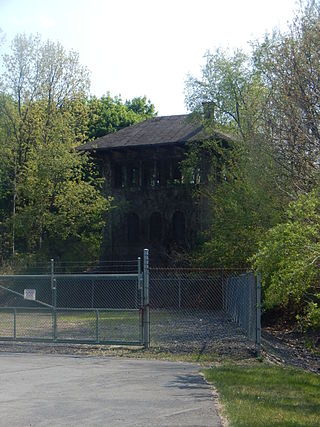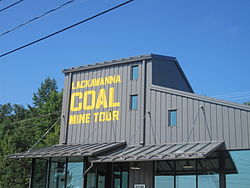
Wilkes-Barre is a city in and the county seat of Luzerne County, Pennsylvania, United States. Located at the center of the Wyoming Valley in Northeastern Pennsylvania, it had a population of 44,328 in the 2020 census. It is the second-largest city, after Scranton, in the Scranton–Wilkes-Barre–Hazleton, PA Metropolitan Statistical Area, which had a population of 567,559 as of the 2020 census, making it the fifth-largest metropolitan area in Pennsylvania.

Luzerne County is a county in the Commonwealth of Pennsylvania. According to the United States Census Bureau, the county has a total area of 906 square miles (2,350 km2), of which 890 square miles (2,300 km2) is land and 16 square miles (41 km2) is water. It is Northeastern Pennsylvania's second-largest county by total area. As of the 2020 census, the population was 325,594, making it the most populous county in the northeastern part of the state. The county seat and largest city is Wilkes-Barre. Other populous communities include Hazleton, Kingston, Nanticoke, and Pittston. Luzerne County is included in the Scranton–Wilkes-Barre–Hazleton Metropolitan Statistical Area, which has a total population of 555,426 as of 2017.

Carbondale is a city in Lackawanna County, Pennsylvania, United States. Carbondale is located approximately 15 miles due northeast of the city of Scranton in Northeastern Pennsylvania. The population was 8,828 at the 2020 census.

Scranton is a city in the Commonwealth of Pennsylvania, United States, and the county seat of Lackawanna County. With a population of 76,328 as of the 2020 U.S. census, Scranton is the largest city in Northeastern Pennsylvania and the Scranton–Wilkes-Barre–Hazleton Metropolitan Statistical Area, which has a population of 562,037 as of 2020. It is the seventh largest city or borough in Pennsylvania. The contiguous network of five cities and more than 40 boroughs all built in a straight line in Northeastern Pennsylvania's urban area act culturally and logistically as one continuous city, so while the city of Scranton itself is a mid-sized city, the larger Scranton/Wilkes-Barre Metropolitan Area contains nearly half a million residents in roughly 200 square miles. Scranton is the cultural and economic center of a region called Northeastern Pennsylvania, which is home to over 1.3 million residents.

Pittston is a city in Luzerne County, Pennsylvania, United States. It is situated between Scranton and Wilkes-Barre in Northeastern Pennsylvania. The city gained prominence in the late 19th and early 20th centuries as an active anthracite coal mining city, drawing a large portion of its labor force from European immigrants. The population was 7,739 as of the 2010 census, making it the fourth largest city in Luzerne County.

The Scranton/Wilkes-Barre RailRiders are a Minor League Baseball team of the International League (IL) and the Triple-A affiliate of the New York Yankees. They are located in Moosic, Pennsylvania, in the Scranton/Wilkes-Barre area, and are named in reference to Northeastern Pennsylvania being home to the first trolley system in the United States. The RailRiders have played their home games at PNC Field since its opening in 1989.

The Coal Region is a region of Northeastern Pennsylvania. It is known for being home to the largest known deposits of anthracite coal in the world with an estimated reserve of seven billion short tons.

The Wyoming Valley is a historic industrialized region of Northeastern Pennsylvania. The region is historically notable for its influence in helping fuel the American Industrial Revolution with its many anthracite coal-mines. As a metropolitan area, it is known as the Scranton/Wilkes-Barre metropolitan area, after its principal cities, Scranton and Wilkes-Barre. With a population of 567,559 as of the 2020 United States census, it is the fifth-largest metropolitan area in Pennsylvania, after the Delaware Valley, Greater Pittsburgh, the Lehigh Valley, and the Harrisburg–Carlisle metropolitan statistical areas.

Northeastern Pennsylvania (NEPA) is a geographic region of the U.S. state of Pennsylvania that includes the Pocono Mountains, the Endless Mountains, and the industrial cities of Scranton, Wilkes-Barre, Pittston, Hazleton, Nanticoke, and Carbondale. A portion of this region is located in the New York City metropolitan area.

McDade Park is a community park located in Scranton in Lackawanna County, in northeastern Pennsylvania. It is named after former U.S. Representative Joseph M. McDade. The park is located on 200 acres (0.81 km2) of land, containing an outdoor pool, a fishing pond as well as a more isolated pond, basketball courts, hiking trails, tennis courts and two picnic pavilions. The park also contains an arboretum and numerous natural gardens. In addition, the park has a children's playground area, a creek, two baseball fields and numerous hills which are ideal for sledding during northeastern Pennsylvania's winter season. The park has free admission for all activities.

The Pennsylvania Anthracite Heritage Museum preserves the heritage of anthracite coal mining in the U.S. State of Pennsylvania and is located in McDade Park in Scranton. It features exhibits detailing the industrial history of northeastern Pennsylvania.
The Lehigh Coal and Navigation Company (LCAN) (1988–2010) was a modern-day anthracite coal mining company headquartered in Pottsville, Pennsylvania. It acquired many properties and relaunched the Lehigh Coal Companies brand in 1988. The LCAN ran strip mining operations in the Panther Creek Valley east of Lansford, Pennsylvania along U.S. Route 209 with vast properties dominating the coal areas of Tamaqua, Coaldale, and Lansford.

The history of coal mining in the United States starts with the first commercial use in 1701, within the Manakin-Sabot area of Richmond, Virginia. Coal was the dominant power source in the late 1800s and early 1900s, and although in rapid decline it remains a significant source of energy in 2023.

Old Forge is a borough in Lackawanna County, Pennsylvania, United States. The population was 8,524 at the 2020 census. It is located 5 miles (8 km) southwest of downtown Scranton and 12 miles (19 km) northeast of Wilkes-Barre.
The Avondale Colliery was a coal mine in Plymouth Township, Luzerne County, near Plymouth, Pennsylvania in the small town of Avondale. The mine was considered to be "one of the best and worst" operating in Pennsylvania's Wyoming Valley.

Duryea Yard is a railroad yard in the Wyoming Valley region of Northeastern Pennsylvania currently operated by the Reading Blue Mountain and Northern Railroad. Originally constructed in 1870 by Lehigh Valley Railroad as a turn-around and staging hub for coal transport from the Coal Region to Eastern big-city markets, the yard remains a hub for the energy extraction industry today.

Gravel Place is a location within Arlington Heights, Pennsylvania, about three miles (4.8 km) northeast of East Stroudsburg. It is neither incorporated nor a census-designated place, but has a name recognized by the USGS. From the 1880s to about 1950, it was a railroad yard of the Delaware, Lackawanna and Western Railroad (DL&W) on its mainline from Hoboken Terminal in New Jersey, which served New York City by ferry, to Scranton, Pennsylvania, continuing northwest into New York State with its western terminus in Buffalo, New York. It is just north of present Mill Creek Road.

Gwilym Gwent, was a Welsh-born composer who immigrated in mid-life to the United States.
The Baltimore Mine Tunnel disaster was an explosion that occurred on June 5, 1919 just inside the mouth of Baltimore Tunnel No. 2. The Delaware and Hudson Coal Company's mine employed 450 workers and was located in Wilkes-Barre, Pennsylvania, about a mile from the center of the city near the modern day corner of North Sherman, Spring, and Pine Streets. Ninety-two miners were killed and 44 injured in the explosion, which was caused by the ignition of black blasting powder. Only 7 miners escaped without injury.
Plymouth, Pennsylvania sits on the west side of Pennsylvania's Wyoming Valley, wedged between the Susquehanna River and the Shawnee Mountain range. Just below the mountain are hills that surround the town and form a natural amphitheater that separates the town from the rest of the valley. Below the hills, the flat lands are formed in the shape of a frying pan, the pan being the Shawnee flats, once the center of the town's agricultural activities, and the handle being a spit of narrow land extending east from the flats, where the center of town is located. At the beginning of the 19th century, Plymouth's primary industry was agriculture. However, vast anthracite coal beds lay below the surface at various depths, and by the 1850s, coal mining had become the town's primary occupation.


















